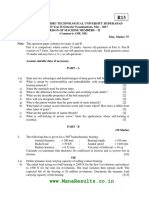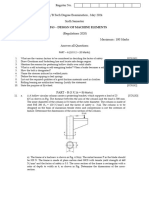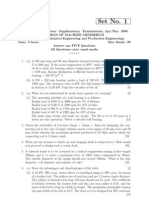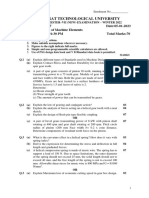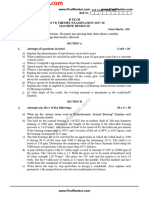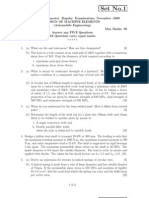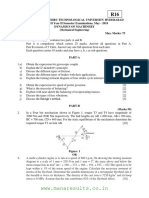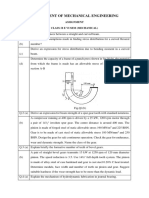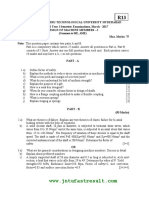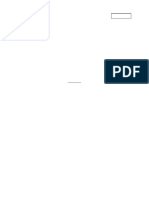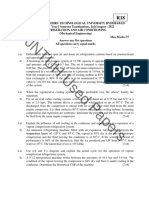0 ratings0% found this document useful (0 votes)
11 viewsR18Feb 2023
R18Feb 2023
Uploaded by
rohitchanakya76Copyright:
© All Rights Reserved
Available Formats
Download as PDF, TXT or read online from Scribd
R18Feb 2023
R18Feb 2023
Uploaded by
rohitchanakya760 ratings0% found this document useful (0 votes)
11 views2 pagesOriginal Title
R18Feb-2023
Copyright
© © All Rights Reserved
Available Formats
PDF, TXT or read online from Scribd
Share this document
Did you find this document useful?
Is this content inappropriate?
Copyright:
© All Rights Reserved
Available Formats
Download as PDF, TXT or read online from Scribd
Download as pdf or txt
0 ratings0% found this document useful (0 votes)
11 views2 pagesR18Feb 2023
R18Feb 2023
Uploaded by
rohitchanakya76Copyright:
© All Rights Reserved
Available Formats
Download as PDF, TXT or read online from Scribd
Download as pdf or txt
You are on page 1of 2
Code No: 156AQ R18
JAWAHARLAL NEHRU TECHNOLOGICAL UNIVERSITY HYDERABAD
B. Tech III Year II Semester Examinations, February - 2023
DESIGN OF MACHINE MEMBERS - II
(Mechanical Engineering)
Time: 3 Hours Max. Marks: 75
Note: i) Question paper consists of Part A, Part B.
JN
ii) Part A is compulsory, which carries 25 marks. In Part A, Answer all questions.
iii) In Part B, Answer any one question from each unit. Each question carries 10 marks
and may have a, b as sub questions.
TU
Assume Suitable data, if necessary.
PART – A
(25 Marks)
1.a) What is bearing characteristic number as applied to journal bearing? [2]
b) Distinguish between “Hydrodynamic bearings” and “Hydro static bearings”. [3]
H
c) Why are ball and roller bearings called anti friction bearings? [2]
d) Enumerate any two advantages and disadvantages of rolling contact bearings to sliding
contact bearings. [3]
U
e) What is the function of gudgeon pin? [2]
f) Enumerate the design considerations for crank pin. [3]
se
g) What are the advantages of fabric rubber belts? [2]
h) Explain the designation of V-belt with the help of examples. [3]
i) State two most important reasons for adopting involute curve for a gear tooth profile.
d
[2]
j) State any four advantages of gear drive over other types of drives. [3]
pa
PART – B
(50 Marks)
2.a) Explain the design procedure of journal bearing.
pe
b) Each bearing of an electrical motor sustains a radial load of 4 kN. Assuming (l/d) ratio
of 1.1, determine the length of the bearing, if the permissible bearing pressure is limited
to 1 N/mm2. [5+5]
rs
OR
3.a) Derive Petroffs equation for the co-efficient of friction in a lightly loaded bearing.
b) The following data are given for a full hydrodynamic bearing: radial load = 25 kN,
journal speed = 900 rpm, unit bearing pressure = 2.5 MPa, (l/d) ratio = 1, viscosity of
20
lubricant = 20 cP, class of fit = H7e7 Calculate: (i) dimensions of the bearing;
(ii) minimum film thickness; and (iii) requirement of oil flow. [5+5]
23
4. The radial reaction on a bearing is 9000 N. It also carries a thrust of 5000N. The speed
of the shaft is 1000 rpm. The outer ring is stationary. Expected average life of bearing
is about 25,000 hours. The load on the bearing is smooth, the service is 8 hours/day.
Select: a) Suitable roller bearing. b) What is the rated 90% life of selected bearing?
c) Compute the probability of the selected bearing surviving 25,000 hours. [10]
OR
5.a) A roller bearing is selected to withstand a radial load of 40 kN and life of 1200 hrs at
600 rpm. What load rating would you look for in searching from manufacturers
catalogue if it specifies load at speed 500 rpm and life 3000 hrs.
b) Select a suitable rolling bearing for a 55 mm diameter shaft. The bearing should be
capable of withstanding 3 kN radial and 1.5 kN axial load at 750 rpm. The bearing is to
have a desired rated life of 2000 hrs at a reliability of 94%. There is a light shock load
and inner ring rotates. [5+5]
6. Determine the dimensions of cross section of the connecting rod for a diesel engine
with the following data: Cylinder bore = 100 mm; Length of connecting rod = 350 mm;
Maximum gas pressure = 4 MPa Factor of safety = 6. [10]
OR
JN
7. Following data are given for a four-stroke diesel engine:
Cylinder bore = 250 mm, Length of stroke = 300 mm, Speed = 600 rpm, Indicated
mean effective pressure = 0.6 MPa, Mechanical efficiency = 80%, Maximum gas
TU
pressure = 4 MPa, Fuel consumption = 0.25 kg per BP per hr, Higher calorific value of
fuel = 44 000 kJ/kg. Assume that 5% of total heat developed in the cylinder is
transmitted by the piston. The piston is made of grey cast iron FG 200
(Sut) = 200 N/mm2 and k = 46.6 W/m/0C) and the factor of safety is 5. The temperature
difference between the centre and the edge of piston head is 2200C.
H
a) Calculate the thickness of piston head by strength consideration.
b) Calculate the thickness of piston head by thermal consideration.
U
c) Which criterion decides the thickness of piston head?
d) State whether ribs required?
e) If so, calculate the number and thickness of the piston ribs.
se
f) State whether a cup is required in the top of piston head?
g) If so, calculate the radius of the cup. [10]
d
8. Select a suitable wire rope for a wire hoist carrying a load of 80 kN to be lifted from a
depth of 100 m. The speed of 10 m/s should be attained in 10 seconds. [10]
OR
pa
9.a) Why Wahl’s factor is to be considered in the design of helical compression or tension
springs? Explain.
b) A load of 3 kN is dropped axially on a close coiled helical compression spring from a
pe
height of 150 mm. The spring has 12 active coils. Take wire diameter as 20 mm, spring
index as 6. Determine the deflection and stress induced in the spring.
Take G = 8.4 × 104 N/mm2. [4+6]
rs
10. It is required to design a pair of spur gears with 200 full-depth involute teeth based on
Lewis equation. The velocity factor is to be used to account for dynamic load. The
pinion shaft is connected to a 10 KW, 1440 rpm motor. The starting torque of the motor
20
is 150% of the rated torque. The speed reduction is 4:1. The pinion as well as the gear
is made of plain carbon steel 40C8 (S = 600 N/mm2). The factor of safety can be taken
as 1.5. Design the gears, specify their dimensions, and suggest suitable surface hardness
23
for the gears. [10]
OR
11. A pair of parallel helical gears consists of a 20 teeth pinion meshing with a 100 teeth
gear. The pinion rotates at 720 rpm. The normal pressure angle is 200, while the helix
angle is 250. The face width is 40 mm and the normal module is 4 mm. The pinion as
well as the gear is made of steel 40C8 (Sut = 600 N/mm2) and heat treated to a surface
hardness of 300 BHN. The service factor and the factor of safety are 1.5 and 2
respectively. Assume that the velocity factor accounts for the dynamic load and
calculate the power transmitting capacity of gears. [10]
---ooOoo---
You might also like
- Machine Design Elements and AssembliesFrom EverandMachine Design Elements and AssembliesRating: 3.5 out of 5 stars3.5/5 (2)
- Asmt E2533Document47 pagesAsmt E2533krperz100% (2)
- WWW - Manaresults.Co - In: (Common To Ame, Me)Document3 pagesWWW - Manaresults.Co - In: (Common To Ame, Me)Vikranth DeepakNo ratings yet
- WWW - Manaresults.co - In: (Mechanical Engineering)Document2 pagesWWW - Manaresults.co - In: (Mechanical Engineering)Mohammed SohailNo ratings yet
- 126VD052019Document2 pages126VD052019rohitchanakya76No ratings yet
- MDDocument2 pagesMDMiraj RajputNo ratings yet
- B.Tech. (Mechanical Engineering), 6Th Semester Machine DesignDocument3 pagesB.Tech. (Mechanical Engineering), 6Th Semester Machine Designawesomesiddharth2001No ratings yet
- rr320305 Design of Machine Members IIDocument8 pagesrr320305 Design of Machine Members IISRINIVASA RAO GANTANo ratings yet
- Design of Machine Elements Question Paper SampleDocument5 pagesDesign of Machine Elements Question Paper SampleK V SATHEESHKUMAR MECHNo ratings yet
- MachineDesign II NewDocument4 pagesMachineDesign II Newretak76086No ratings yet
- 15A03602 Design of Machine Members - IIDocument2 pages15A03602 Design of Machine Members - IIJagannath CherkuNo ratings yet
- MDDocument2 pagesMDAbhijeet PramanikNo ratings yet
- Gujarat Technological UniversityDocument3 pagesGujarat Technological Universityrajushamla9927No ratings yet
- rr320305 Design of Machine Members IIDocument8 pagesrr320305 Design of Machine Members IISrinivasa Rao GNo ratings yet
- DESIGN OF MACHINE ELEMENTS Question PaperDocument4 pagesDESIGN OF MACHINE ELEMENTS Question PaperL RevathiNo ratings yet
- Be Winter 2022Document2 pagesBe Winter 2022shivamparmartechNo ratings yet
- Machine Design IIDocument3 pagesMachine Design IIRushabh PatelNo ratings yet
- Design of Machine Elements Question Paper SampleDocument5 pagesDesign of Machine Elements Question Paper SampleK V SATHEESHKUMAR MECHNo ratings yet
- Makalah GTWDocument8 pagesMakalah GTWfaisalNo ratings yet
- Gujarat Technological UniversityDocument3 pagesGujarat Technological UniversityAashay patelNo ratings yet
- Be Summer 2022Document3 pagesBe Summer 2022Karan SheladiyaNo ratings yet
- r05312401 Design of Machine ElementsDocument8 pagesr05312401 Design of Machine ElementsSrinivasa Rao GNo ratings yet
- Design of Machine Members-II Feb 2022Document3 pagesDesign of Machine Members-II Feb 2022Anand KedhariNo ratings yet
- Attempt All Sections. If Require Any Missing Data Then Choose Suitably. Standard Design Data Book Is AllowedDocument3 pagesAttempt All Sections. If Require Any Missing Data Then Choose Suitably. Standard Design Data Book Is Allowedvk862626No ratings yet
- rr312404 Design of Machine ElementsDocument8 pagesrr312404 Design of Machine ElementsSRINIVASA RAO GANTANo ratings yet
- 2019 May ME402-A - Ktu QbankDocument3 pages2019 May ME402-A - Ktu Qbankbilalfocus0% (1)
- Design of Machine Elements Question Paper SampleDocument5 pagesDesign of Machine Elements Question Paper SampleK V SATHEESHKUMAR MECHNo ratings yet
- Design of Machine Elements Question Paper SampleDocument5 pagesDesign of Machine Elements Question Paper SampleK V SATHEESHKUMAR MECHNo ratings yet
- Ilovepdf - Merged - 2024-02-25T160140.090Document10 pagesIlovepdf - Merged - 2024-02-25T160140.090Aman SharmaNo ratings yet
- Machine Design Ii Nme602 1Document3 pagesMachine Design Ii Nme602 1himanshujaiswal04596No ratings yet
- Design of Machine Elements Question Paper SampleDocument6 pagesDesign of Machine Elements Question Paper SampleK V SATHEESHKUMAR MECHNo ratings yet
- Design of Machine Elements Question Paper SampleDocument7 pagesDesign of Machine Elements Question Paper SampleK V SATHEESHKUMAR MECHNo ratings yet
- Design of Machine Elements Oct 2017Document3 pagesDesign of Machine Elements Oct 2017Kalpesh JadhavNo ratings yet
- Stucor Qp-Me8593 PDFDocument22 pagesStucor Qp-Me8593 PDFSalmon JNo ratings yet
- Design of Machine Elements Question Paper SampleDocument5 pagesDesign of Machine Elements Question Paper SampleK V SATHEESHKUMAR MECHNo ratings yet
- Design of Machine Elements Question Paper SampleDocument7 pagesDesign of Machine Elements Question Paper SampleK V SATHEESHKUMAR MECHNo ratings yet
- Me 7 Sem Subject Design of Mechanical Drives Jun 2017Document2 pagesMe 7 Sem Subject Design of Mechanical Drives Jun 2017djniksthehearteditorNo ratings yet
- Design of Machine Elements Question Paper SampleDocument5 pagesDesign of Machine Elements Question Paper SampleK V SATHEESHKUMAR MECHNo ratings yet
- WWW - Manaresults.co - In: (Mechanical Engineering)Document3 pagesWWW - Manaresults.co - In: (Mechanical Engineering)rajuNo ratings yet
- Design of Machine Elements Question Paper SampleDocument7 pagesDesign of Machine Elements Question Paper SampleK V SATHEESHKUMAR MECHNo ratings yet
- Assignment DME-II 2024Document2 pagesAssignment DME-II 2024bossali138786No ratings yet
- Dmm2 Mar2006Document8 pagesDmm2 Mar2006Abdul Saleem MohammedNo ratings yet
- No of Pages: 4 Course Code: 12M502: Fig.1 Fig 2Document4 pagesNo of Pages: 4 Course Code: 12M502: Fig.1 Fig 2CRAZY PIANO PLAYERNo ratings yet
- Machine Design-IIDocument2 pagesMachine Design-IIPrathamesh MhatreNo ratings yet
- MD-II Question BankDocument2 pagesMD-II Question BankmaheshNo ratings yet
- Machine Design-II EME 602 - NEWDocument4 pagesMachine Design-II EME 602 - NEWnitin_johriNo ratings yet
- Design of Machine Members: Part-ADocument4 pagesDesign of Machine Members: Part-ARkrishna ANo ratings yet
- Me1302 Dme 2Document4 pagesMe1302 Dme 2sumikannu100% (1)
- (Common To ME, AME) : 2 2 Ut 2 Yt 2 2Document2 pages(Common To ME, AME) : 2 2 Ut 2 Yt 2 2Faisal PashaNo ratings yet
- Dme T.E (2019 Pattern) Oct 22Document4 pagesDme T.E (2019 Pattern) Oct 22vaibhavraut58thNo ratings yet
- Gujarat Technological UniversityDocument3 pagesGujarat Technological UniversityHarshit PatelNo ratings yet
- Machine Design - II: (Also Old Sem-VI Equivalence) (126112)Document2 pagesMachine Design - II: (Also Old Sem-VI Equivalence) (126112)Harshal DesaleNo ratings yet
- MET401 - Dec 2022Document4 pagesMET401 - Dec 2022varunraj.x11aNo ratings yet
- Machine Design IIDocument3 pagesMachine Design IIRushabh PatelNo ratings yet
- MailordDocument2 pagesMailordPeter MuriithiNo ratings yet
- 14 ACAD-R-45 - Unit Test QPDocument9 pages14 ACAD-R-45 - Unit Test QPsomnath swamiNo ratings yet
- Gujarat Technological UniversityDocument1 pageGujarat Technological Universityamit UpadhyayNo ratings yet
- High Speed Off-Road Vehicles: Suspensions, Tracks, Wheels and DynamicsFrom EverandHigh Speed Off-Road Vehicles: Suspensions, Tracks, Wheels and DynamicsNo ratings yet
- Internal Combustion Engine Bearings Lubrication in Hydrodynamic BearingsFrom EverandInternal Combustion Engine Bearings Lubrication in Hydrodynamic BearingsNo ratings yet
- Design and Analysis of Composite Structures for Automotive Applications: Chassis and DrivetrainFrom EverandDesign and Analysis of Composite Structures for Automotive Applications: Chassis and DrivetrainNo ratings yet
- May - 2019Document3 pagesMay - 2019rohitchanakya76No ratings yet
- JulyAugust 2022Document2 pagesJulyAugust 2022rohitchanakya76No ratings yet
- AugustSeptember 2021Document1 pageAugustSeptember 2021rohitchanakya76No ratings yet
- AugustSeptember 2021Document1 pageAugustSeptember 2021rohitchanakya76No ratings yet
- FebruaryMarch 2022Document2 pagesFebruaryMarch 2022rohitchanakya76No ratings yet
- Ime February-2023Document2 pagesIme February-2023rohitchanakya76No ratings yet
- Important Questions For VibrationsDocument3 pagesImportant Questions For Vibrationsrohitchanakya76No ratings yet
- Dynamics of Machinery R16 - UNIT-1Document37 pagesDynamics of Machinery R16 - UNIT-1rohitchanakya76No ratings yet
- 115 Dy 052018Document3 pages115 Dy 052018rohitchanakya76No ratings yet
- 115DY122016Document3 pages115DY122016rohitchanakya76No ratings yet
- 115 Dy 052019Document2 pages115 Dy 052019rohitchanakya76No ratings yet
- Ideal Fluid Real Fluid Newtonian Fluid Non - Newtonian Fluid Ideal Plastic Fluid With ExamplesDocument12 pagesIdeal Fluid Real Fluid Newtonian Fluid Non - Newtonian Fluid Ideal Plastic Fluid With Exampleshammadh28No ratings yet
- 2D NMR HandoutDocument3 pages2D NMR HandoutraisameongNo ratings yet
- SportsDocument18 pagesSportsRoger MelkoNo ratings yet
- Simulation and Analysis of A Rube Goldberg Machine Engineering Static (MEC60104) Module Coordinator: DR Lim Joon HoongDocument28 pagesSimulation and Analysis of A Rube Goldberg Machine Engineering Static (MEC60104) Module Coordinator: DR Lim Joon HoongCovyn YongNo ratings yet
- H-Cube Mini Application OverviewDocument2 pagesH-Cube Mini Application OverviewMiruna PetriaNo ratings yet
- Fracture Mechanics Analysis of CoatingDocument12 pagesFracture Mechanics Analysis of CoatingBisma MasoodNo ratings yet
- Polymer Flooding: ChallengesDocument11 pagesPolymer Flooding: Challengesحسين رامي كريم A 12No ratings yet
- Going Local How Coastal Environmental Settings CanDocument6 pagesGoing Local How Coastal Environmental Settings CanrjhonnerieNo ratings yet
- Materials Science in Semiconductor ProcessingDocument6 pagesMaterials Science in Semiconductor ProcessingAbhishek AttriNo ratings yet
- 1.5DL+1.5LL - 1500mm TRIB - CONTI. SUPPORTED - NAUS 01 PDFDocument11 pages1.5DL+1.5LL - 1500mm TRIB - CONTI. SUPPORTED - NAUS 01 PDFDinesh PatilNo ratings yet
- The Peltier Effect: Jacob Mckenzie, Ty Nowotny, Colin Neunuebel SRJC Engr45 - Fall 2005Document13 pagesThe Peltier Effect: Jacob Mckenzie, Ty Nowotny, Colin Neunuebel SRJC Engr45 - Fall 2005Mudavath BaburamNo ratings yet
- HDPE - PVC Heat Fusion Joining ProcedureDocument32 pagesHDPE - PVC Heat Fusion Joining Proceduresentunali100% (1)
- Technical Paper - FormatDocument5 pagesTechnical Paper - FormatjohnjabarajNo ratings yet
- 554 Book Reviews Pressure Vessel Design: Nuclear and ChemicalDocument2 pages554 Book Reviews Pressure Vessel Design: Nuclear and ChemicalArun KumarNo ratings yet
- Phosphorescent Organic Light Emitting Devices (PHOLEDs)Document52 pagesPhosphorescent Organic Light Emitting Devices (PHOLEDs)d-fbuser-29132180100% (1)
- PIM600 ConstructionDocument54 pagesPIM600 Constructionmika cabelloNo ratings yet
- Continuity EquationDocument2 pagesContinuity EquationKASHIF USMAN L1S16MSME0003No ratings yet
- NC-SMQ®90 Solder Paste: Product Data SheetDocument2 pagesNC-SMQ®90 Solder Paste: Product Data SheetbrunizzaNo ratings yet
- Valve Type 3010 2CH A3Document2 pagesValve Type 3010 2CH A3univers durNo ratings yet
- Railway Track: - Railway Track Components - Functions of Track Components - Track ForcesDocument23 pagesRailway Track: - Railway Track Components - Functions of Track Components - Track ForcesAbdullah Abbas SabbarNo ratings yet
- Dinstruk 2 Gak GabutDocument5 pagesDinstruk 2 Gak GabutAbdi Kurnia GustiNo ratings yet
- CHEM320 Prac 1Document2 pagesCHEM320 Prac 1shenayNo ratings yet
- FragAnal RC QDocument26 pagesFragAnal RC QhjmaranhaoNo ratings yet
- SCI6 Q1 WK3 D1 PretestDocument11 pagesSCI6 Q1 WK3 D1 PretestJaypee SembilloNo ratings yet
- Numericals Class IX TMHDocument80 pagesNumericals Class IX TMHMr. JocularNo ratings yet
- Method For Quenching A Gas Stream in The Production of Vinyl Chlorde MonomerDocument9 pagesMethod For Quenching A Gas Stream in The Production of Vinyl Chlorde Monomeru2051721No ratings yet
- Autodyn 11Document4 pagesAutodyn 11malakayjrNo ratings yet
- 5 Ton BoilerDocument3 pages5 Ton BoilerShagor Ahmed PrantoNo ratings yet
- Analisis Kondisi Vertical Windshear Terhadap PergerakanDocument12 pagesAnalisis Kondisi Vertical Windshear Terhadap Pergerakanherdi sutanto adigunaNo ratings yet


